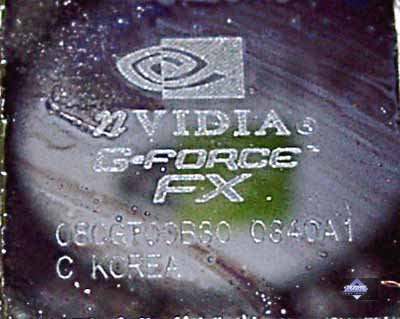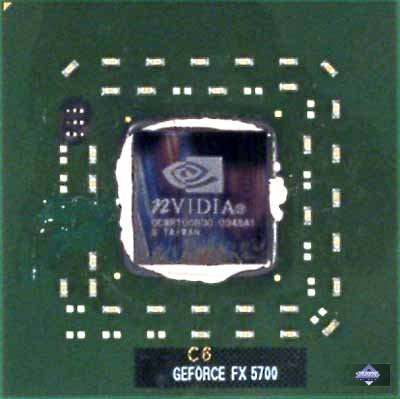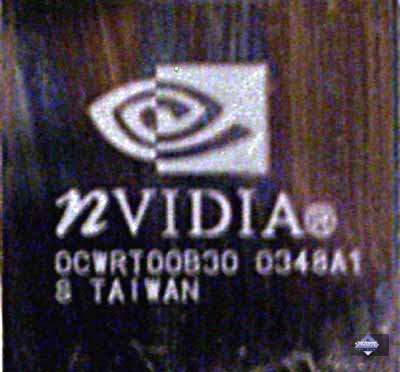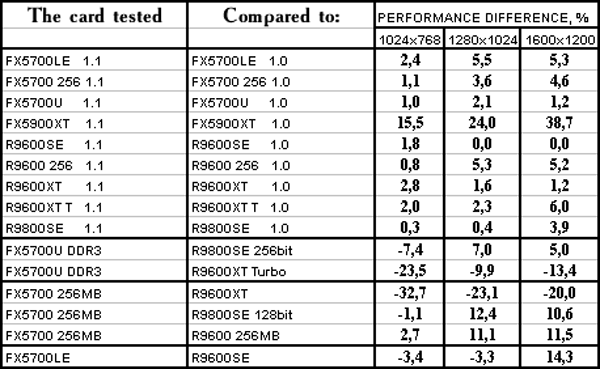CONTENTS
- Videocards' features
- Testbed configurations, test tools, quality in 2D
- FarCry test results: quality issues
- FarCry test results: performance diagrams
- Conclusions
Well, previous generations of accelerators are exhausted. There has been nothing new in middle and low segments for several months. FX 5700LE, 5600XT, 5700 Ultra, DDR3, and other that have appeared
are more like reincarnations of older products.
Does a user that has FX 5600 Ultra or 5600 need them? We wouldn't say so.
Of course, FX 5700 will leave FX 5600 far behind in old games where chip frequency values were crucial. But if we take latest games with shaders 2.0, not all of new NVIDIA products have a visible advantage there.
But is GeForce FX really so bad as not to be taken into account speaking about latest games? No, in fact, it's not so bad. It's only in pure speed of shaders 2.0 that the lag is so great, and we have repeatedly touched upon it.
Theoretical materials and videocard reviews concerning GPU NVIDIA GeForce FX functionality:
- Analysis of the architecture
of NVIDIA NV30 (GeForce FX)
- NVIDIA GeForce FX
5800 Ultra (NV30) - single-page review
- NVIDIA GeForce FX
5800 Ultra (NV30) - multi-page review
- NVIDIA GeForce FX 5600
Ultra (NV31) and GeForce FX 5200 Ultra (NV34) - single-page
review
- NVIDIA GeForce FX 5600
Ultra (NV31) and GeForce FX 5200 Ultra (NV34) - multi-page review
- ASUS V9900 Ultra on
NVIDIA GeForce FX 5800 Ultra - AA and anisotropy quality
- Gainward FX Powerpack
Ultra/1000 Golden Sample and Gainward FX Powerpack Pro/660 TV/DVI
on NVIDIA GeForce FX 5800 Ultra and 5200 - scaling (performance
vs. CPU clock speed) of GeForce FX 5800 Ultra, performance of GeForce
FX 5200
- Leadtek WinFast
A300 Ultra MyVIVO on NVIDIA GeForce FX 5800 Ultra - performance
of GeForce FX 5800 Ultra vs. CPU clock speed in heavy modes with
AA and anisotropy enabled
- MSI FX5800 Ultra-TD8X
on NVIDIA GeForce FX 5800 Ultra
- Albatron, Chaintech, Gainward,
InnoVision, Leadtek, Palit and Prolink video cards on NVIDIA GeForce
FX 5200
- ASUSTeK NVIDIA GeForce
FX 5200/5600 video cards
- MSI FX5600-VTDR128 (MS-8912)
card on NVIDIA GeForce FX 5600
- Albatron, Leadtek and MSI
video cards on the NVIDIA GeForce FX 5200 Ultra
- Prolink PixelView GeForce FX 5600 256MB
Golden Limited on the NVIDIA GeForce FX 5600
- Gainward FX PowerPack Ultra/760 XP Golden
Sample on the NVIDIA GeForce FX 5900 (new revision)
- AOpen and Soltek cards on NVIDIA GeForce
FX 5600
- Leadtek WinFast A310 Ultra MyVIVO on NVIDIA
GeForce FX 5600 Ultra (350MHz revision)
- ATI vs NVIDIA: where are fair
duels? or Dishonest Treatment of the 3DMark
- MSI FX5900-VTD128 on NVIDIA GeForce FX
5900 - More on 3DMark 2003 (fruits of collaboration of NVIDIA
and FutureMark after signing the peaceful agreement)
- Gainward FX Powerpack Ultra/1200 Golden
Sample on NVIDIA GeForce FX 5900 - performance in NEW game tests,
analysis of performance of the FX 5900 without cheats
- Albatron Gigi GeForce FX 5900PV 128MB
on NVIDIA GeForce FX 5900 Ultra
- Inno3D Tornado GeForce FX5900 128MB on
NVIDIA GeForce FX 5900
- ASUS V9950 Ultra on NVIDIA GeForce FX
5900 Ultra - extremal overclocking
- AOpen Aeolus GeForce FX 5600S 256MB on
NVIDIA GeForce FX 5600
- ABIT, ASUSTeK and Chaintech cards on the
NVIDIA GeForce FX 5600 Ultra
- Gainward Powepack FX Ultra/1600 GS CoolFX on the NVIDIA GeForce
FX 5900 Ultra - Drivers 51.75 beta
- Gainward Powepack FX Ultra/1600 GS CoolFX
on the NVIDIA GeForce FX 5900 Ultra - Drivers 51.75 beta
- Prolink PixelView GeForce FX 5900 128MB
on NVIDIA GeForce FX 5900 - Tomb Raider: Angel of Darkness Benchmark
- NVIDIA GeForce FX 5900SE/XT from Albatron
and Leadtek
- NVIDIA GeForce FX 5950 Ultra (NV38) and
GeForce FX 5700 Ultra (NV36)
- Gigabyte GeForce FX 5950 Ultra 256MB
- drivers 52.70 vs 52.16
- Albatron Gigi GeForce FX 5700 Ultra 128MB
on NVIDIA GeForce FX 5700 Ultra
- Leadtek WinFast A380 Ultra MyVIVO 256MB
and ASUS V9950SE on NVIDIA GeForce FX 5950Ultra/5900SE
- Chaintech GeForce FX 5600XT 128MB 64bit;
Chaintech GeForce FX 5600XT 256MB 128bit; Chaintech GeForce FX 5700
Ultra 128MB; Chaintech GeForce FX 5900 128MB; Chaintech GeForce
FX 5950 Ultra 256MB
- Gainward CoolFX Ultra/1800 XP GS 256MB
on NVIDIA GeForce FX 5950Ultra
- MSI FX5950 Ultra-VTD256 & MSI FX5700
Ultra-TD128 on NVIDIA GeForce FX 5950Ultra/5700Ultra &emdash;
3DMark03 v.340 on drivers 52.16 & 53.0
- NVIDIA GeForce FX 5700 Ultra cards from
AOpen, InnoVision and Sparkl
- ASUS V9570 TD 256MB and ASUS V9560XT/TD
128MB (64bit) on NVIDIA GeForce FX 5700/5600XT
- Gigabyte GeForce FX 5950 Ultra-GT and Gigabyte
GeForce FX 5700 Ultra on NVIDIA GeForce FX 5950/5700
- NVIDIA GeForce FX 5900XT from AOpen, Chaintech
and MSI
- CHAINTECH FX5700 Ultra Apogee AA5700U and
CHAINTECH FX5700 SA5700 128MB on NVIDIA GeForce FX 5700/5700Ultra
- Albatron Gigi GeForce FX 5950 Ultra, ASUS
V9980 Ultra on NVIDIA GeForce FX 5950 Ultra & FarCry DEMO Benchmarking
But the NVIDIA company is not only known for its expansive GF FX family, it is also famous for a well-coordinated work with game developers. A lot of people have heard about the program The Way It's Meant To Be Played, and nowadays you can hardly find a developer not belonging to this cohort. NVIDIA programmers cooperate closely with game authors, fine-tuning every shader and every step to reduce NVIDIA-cards' gap and, more importantly, to eliminate bugs.
It is bad if a game code is replaced with another one without the developers knowing about it, or if a shader is modified in such a way that it becomes simpler in terms of calculations but the picture changes (sometimes for the worse). On the contrary, it is good if cooperation with programmers brings about a more effective code that can be times faster executed by the accelerator and the picture quality doesn't suffer.
So evidently, the ATI company should come up with a similar cooperation plan to eliminate (or, at least, to lessen) problems in game accelerators.
Back to the subject, though. Today, apart from the three mentioned cards,
we'll also dwell on accelerators' performance in the new game FarCry.
Last time we only took its DEMO-version,
today we'll test the cards in the final game. Its authors take part
in the NVIDIA program too, so it will be quite interesting to see
in action a new patch 1.1 for GeForce FX series accelerators.
As for the cards, we don't think it's necessary to tell about Leadtek and Prolink companies as they are already well-known on the Russian market. Their products are not only quality enough but also have some specialities. Today we'll take a look at a couple of them too.
And one more thing. Why did they decide to use GDDR3 memory for GeForce FX 5700 Ultra based cards that seemingly cater to the middle sector?
I have already posed the question whether products cheaper than USD 200 really need DDR2 memory. Not only the memory is expensive itself, but it also needs a high-priced shielded PCB. Besides, there is the FX 5900XT which is "ruining" 5700 Ultra by having the same price. As long as 5900XT is on sale, 5700 Ultra will hardly find its market niche. Obviously, the latter product should be sold at lower prices. But then again, its latest version with the new and very expensive GDDR3 memory will surely raise the product's price. Whereas a higher memory frequency won't be much of an advantage for 5700 Ultra and won't make it competitive with 5900XT. The only explanation that comes to mind is that setting DDR2 and GDDR3 on serial products is a kind of test for memory and PCB reliabilities. The results will be analysed and later used in the development of more advanced PCBs for NV40 and the likes.
So, we have three videocards: two from Leadtek, one from Prolink. All of them belong to the middle-end sector.
Boards
| Leadtek WinFast A360 Ultra TDH 128MB
DDR3 |

|
| Leadtek WinFast A360LE TD 128MB |

|
| Prolink PixelView GeForce FX 5700 PDF
256MB |

|
|
Leadtek WinFast A360LE TD 128MB
|
|
The card is based on GeForce FX 5700LE, has an AGP x8/x4/x2 interface, and a 128-MB DDR SDRAM memory
allocated in 8 chips on the front side of the PCB.
Memory chips are of Hynix make.
Their access time is 5ns, which corresponds to a 200(400)-MHz memory frequency (and which is the frequency the memory works at). GPU frequency is 250 MHz.
Memory bus is 128 bits.
|

|
| Leadtek WinFast A360 Ultra TDH 128MB DDR3 |
|
The card is based on GeForce FX 5700 Ultra, has an AGP x8/x4/x2 interface, and a 128-MB GDDR3 SDRAM memory allocated in 4 chips on the front side of the PCB.
The memory chips are of Samsung make.
Their access time is 2ns, which corresponds to a 500(1000)-MHz memory frequency, while the memory works at 475 (950) MHz. GPU frequency is 475 MHz.
Memory bus is 128 bits.
|

|
| Prolink PixelView GeForce FX 5700 PDF 256MB |
|
The card is based on GeForce FX 5700, has an AGP x8/x4/x2 interface, and a 256-MB DDR SDRAM memory allocated in 8 chips on the front side of the PCB.
THe memory chips are of Samsung make.
Their access time is 3.3ns, which corresponds to a 300(600)-MHz memory frequency (and which is the frequency the memory works at). GPU frequency is 425 MHz.
Memory bus is 128 bits.
|

|
|
Comparison with the reference design, front view |
| Leadtek WinFast A360 Ultra TDH 128MB DDR3 |
Reference card NVIDIA GeForce FX 5700 Ultra DDR2
|

|

|

|
| Leadtek WinFast A360LE TD 128MB |
Reference card NVIDIA GeForce FX 5200 |

|

|
| Prolink PixelView GeForce FX 5700 PDF 256MB |
Reference card NVIDIA GeForce FX 5700 |

|

|

|
| Comparison with the reference design, back view
|
| Leadtek WinFast A360 Ultra TDH 128MB DDR3 |
Reference card NVIDIA GeForce FX 5700 Ultra DDR2
|

|

|
| Leadtek WinFast A360LE TD 128MB |
Reference card NVIDIA GeForce FX 5200 |

|

|
| Prolink PixelView GeForce FX 5700 PDF 256MB |
Reference card NVIDIA GeForce FX 5700 |

|

|

|
It is not by chance that we compared FX 5200 with FX 5700LE: their PCBs are virtually identical, only the chips are different. And that clearly indicates that the product is low-sector oriented. By the way, speaking about the product line for low and middle sectors, today it is represented by FX 5200, 5500 (an accelerated 5200), 5700LE, 5700, and 5700 Ultra. All versions of FX 5600 based cards are now things of the past. Of course, they are still available but not produced any more. And 5600XT were made specially to ensure a quick disappearance of 5600, ahead of the 5700 assault on the market. The idea was to sell 5600XTs at lower-than-real prices, which was believed helpful for a quicker riddance of the 5600 stock.
FX 5200 is still produced in two versions: with 64-bit and 128-bit memory buses. Then comes 5500 — the same
5200, but with the chip frequency of 270 MHz, instead of 250. Then follows 5700LE (examined today), then 5700, and finally, FX 5700 Ultra (its version with DDR3 is also examined today).
Certainly, it's a bit difficult for customers when the market is full of both old and new products catering to one and the same segment. But that is why we have our 3Digest monthly reviews, where you can read, for instance, what is better: 5600 or 5700LE, 5200 or 5600XT, and so on.
Now let's get back to the videocards and their features. It's evident that Prolink's FX 5700 is based on a reference design, and only has larger-volume memory chips. Leadtek WinFast A360 Ultra TDH 128MB DDR3, too, is a reference-card copy with larger-volume memory chips of another type. So, four front-side chips are quite enough for 128 MB, and the other side has empty spaces for another set of chips that would make a 256-MB card.
Now we'll take a look at the cooling devices. Leadtek WinFast A360LE TD 128MB
has a standard cooler not worthy of special attention.
|
Leadtek WinFast A360 Ultra TDH 128MB DDR3
|
|
The cooling system consists of a large central cooler based on an aluminium heatsink with a powerful grid-covered fan in the centre. It also contains smaller heatsinks that cool memory chips in pairs. There is nothing new in it comparing to the previous 5700 Ultra version.
|

|

|
| Prolink PixelView GeForce FX 5700 PDF 256MB |
|
This system is, on the contrary, quite original. Even its very name is something special: PDF (Plasma Display Fan). The card is wrapped in a sort of armour, or a shell. Over the armour there is a display tilting towards the card's front side. Both the fan and the display have blue backlight. The display shows the values of temperature and fan rotation frequency.
Under the shell there is a PCB with its own speaker that signals an over-70° temperature increase.
The thermal sensor is allocated on the other side of the card; its probe rests against the PCB's back part where the GPU is.
The back sides of the memory chips are pressed and cooled by a heatsink which also serves for fixing the thermal sensor. But there is nothing that would cool the memory's front side, which is quite unusual. Memory is normally cooled in the following way: a big heatsink placed before the motherboard shields both the chip and the memory, while there is nothing at all at the back and the memory chips are not cooled. Here the situation is quite opposite. |

|

|

|

|
In our opinion, Prolink PixelView GeForce FX 5700 PDF 256MB is a beautiful and effective-looking card:
But it is strange that the display be turned toward the card's front, as cards are normally placed this side down. We would rather recommend to leave the display parallel to the shell's butt-end or to turn it vice-versa. Then a case with a transparent door would enable the user to see the readings.
The product is also supplied with an external Philips 7114 TV-codec, and therefore, supports VIVO.
Now let's take a look at the CPUs:
Leadtek WinFast A360 Ultra TDH 128MB DDR3


Prolink PixelView GeForce FX 5700 PDF 256MB


Leadtek WinFast A360 LE TD 128MB

Architecturally speaking, we have one and the same chip, only selected for work at different frequencies: 475, 425, and 250 MHz, respectively.
Now let's look at the complete delivery package.
|
Leadtek WinFast A360 Ultra TDH 128MB DDR3
|
|
The package includes: a user's manual, a CD with drivers and utilities, 2 games, TV extension cords, a DVI-to-d-Sub adapter, an S-Video-to-RCA adapter, a power cord splitter.
|

|
| Leadtek WinFast A360LE TD 128MB |
|
The same package, except no power cord splitter is included.
|

|
| Prolink PixelView GeForce FX 5700 PDF 256MB |
|
The package includes: a user's manual, a CD with drivers and utilities, WinDVD, VIVO software,
DVI-to-d-Sub and VIVO adapters, TV extension cords.
|

|
And these are the boxes:
|
Leadtek WinFast A360 Ultra TDH 128MB DDR3
|
|
The box is made of thick cardboard and pictures a hero of an imaginary game. In general, the box is pleasant to the eye, only the letters DDR3 seem to be a bit out of place.
|

|
| Leadtek WinFast A360LE TD 128MB |
|
The style is similar to the previous box.
|

|
| Prolink PixelView GeForce FX 5700 PDF 256MB |
|
It is a large box made of thick cardboard, with a window allowing to see the card. The box is colourful and catchy, a good designers' job.
|

|

|
Installation and drivers
Configurations of testbeds:
- Pentium 4 3200 MHz based computer:
- Intel Pentium 4 3200 MHz CPU;
- DFI LANParty Pro875 (i875P) mainboard;
- 1024 MB DDR400 SDRAM;
- Seagate Barracuda IV 40GB HDD;
- Windows XP SP1; DirectX 9.0b;
- ViewSonic P810 (21") and Mitsubishi Diamond Pro 2070sb (22") monitors.
- NVIDIA drivers version 56.72.
VSync and S3TC are OFF in applications.
Test results
Before we start examining 2D quality, we should say there are no complete techniques for objective 2D quality estimation because:
- 2D quality much depends on certain samples for almost all modern 3D accelerators;
- Besides videocards, 2D quality depends on monitors and cables;
- Moreover, certain monitors might not work properly with certain video cards.
With the Mitsubishi Diamond Pro 2070sb monitor the tested cards showed excellent
quality at the following resolutions and clock speeds:
| Leadtek WinFast A360 Ultra TDH 128MB DDR3 |
1600x1200x85Hz, 1280x1024x100Hz, 1024x768x100Hz
|
| Leadtek WinFast A360LE TD 128MB |
1600x1200x75Hz, 1280x1024x85Hz, 1024x768x100Hz
|
| Prolink PixelView GeForce FX 5700 PDF 256MB |
1600x1200x85Hz, 1280x1024x120Hz, 1024x768x120Hz
|
Test results
Test applications:
- Fac Cry (Crytek/UbiSoft), DirectX 9.0, multitexturing, demo01 (the game starts with the -DEVMODE option), all test settings are Very High.
One of our aims is to examine the difference between versions 1.0 and 1.1 (the patch has recently appeared). According to the developers, the new version has a considerably higher speed on GeForce FX. We'll also try to find out if it has had any impact on the quality.
Those willing to receive demo01 can address the author by e-mail.
Quality
First of all, let us look at the game and its rendering quality.
| Far Cry, example 1 |
| GeForce FX |
RADEON 9600 |
| Version 1.0 |
Version 1.1 |
Version 1.0 |
Version 1.1 |
| No ANIS |

|

|

|

|
| ANIS |

|
- |

|
- |
| No ANIS |

|

|

|

|
| ANIS |

|
- |

|
- |
| Far Cry, example 2 |
| GeForce FX |
RADEON 9600 |
| Version 1.0 |
Version 1.1 |
Version 1.0 |
Version 1.1 |
| No ANIS |

|

|

|

|
| ANIS |

|
- |

|
- |
| No ANIS |

|

|

|

|
| ANIS |

|
- |

|
- |
| Far Cry, example 3 |
| GeForce FX |
RADEON 9600 |
| Version 1.0 |
Version 1.1 |
Version 1.0 |
Version 1.1 |

|

|

|

|
| Water Ultra High quality |

|
- |

|
- |
Evidently, version 1.1 has made changes to some scenes, related to somewhat different algorithms of lighting calculations. But it's not better/worse changes, and you can choose what you prefer. Anyway, we can state that at first examination patch 1.1 didn't worsen the quality. See more details in our April 3Digest review.
Now for the speed. We'll see if there is any increase.
Test results: performance
So, as we can see, version 1.1 virtually didn't increase performance, except for the FX 5900 family (on the example of FX 5900XT) where it rised dramatically. And no damage to the quality was caused.
As we tested the quality in both FX 5700 and FX 5900, the identical results enable us to pronounce quality the same for the whole GeForce FX family.
Comparing the tested cards with their competitors, we can say that the picture is not so pleasant for NVIDIA lovers. Although it was clear from the start that GF FX loss was inevitable in games full of shaders 2.0. But it's not so bad next to GF FX lags in TRAoD or HL2. NVIDIA cards can even be competitive with some others, like RADEON 9800SE. Of course, we see that the speed is not so high in general, and "playability" is at the bottom of sufficiency even without AA and anisotropy. Therefore, in a game like this, middle-end
cards can be used either at a lower resolution or at lower quality.
Conclusions
- Leadtek WinFast A360 Ultra TDH 128MB DDR3 is a quality product of a top brand. DDR3
memory enabled to lessen the card's heating and to increase memory frequencies. It can become a solid ATI rival in its segment,... but only after GeForce FX 5900XT disappears from the market — the product that has made 5700 Ultra absolutely unappealing to customers because of an equal price (about USD 200 early in April). Overclocking is excellent in this card, it makes 575/1150 MHz.
- Surprising as it may seem, but Leadtek WinFast A360LE TD 128MB proved to be a viable rival to RADEON 9600SE. Both products have
DX9, but the latter has a shortened bus, which can affect its performance negatively in other tests and games. The mentioned 5700LE has a 128-bit bus. Prices are almost equal (about USD 100 early in April). A 400/500 MHz overclocking is not bad, and there are no claims about stability.
- Prolink PixelView GeForce FX 5700 PDF 256MB is a good and fashionable product. Its image plays an important role, but apart from IT-aesthetes, the card will certainly make a good present for overclockers, as it can be overclocked up to 530/650 MHz, which is very good for FX5700.
Unfortunately, the price for the product is a bit too high (about USD 180 early in April), but the variant is surely worth considering (don't forget that it has VIVO, increased memory frequencies, and a unique design).
See our 3Digests for more detailed comparisons
in various types of videocards.
Write a comment below. No registration needed!








